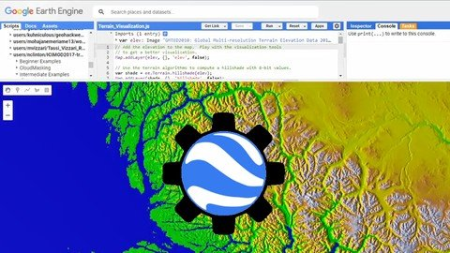
MP4 | Video: h264, 1280x720 | Audio: AAC, 44.1 KHzLanguage: English | Size: 1.07 GB | Duration: 1h 33m
Get started with geospatial data by applying the jаvascript programming language
What you'll learn
Google Earth Ee (GEE)
Basics of Google Earth Ee oriented jаvascript (JS) Programming language
Working with vector and raster datasets
Reducing and Clipping image collectionFiltering the feature or image collection
Automation
Requirements
Geographic information basics
Description
Google Earth Ee is a platform for scientific analysis and visualization of geospatial datasets, for acad, non-profit, business and government users.
Google Earth Ee hosts satellite imagery and stores it in a public data archive that includes historical earth images going back more than forty years. The images, ingested on a daily basis, are then made available for global-scale data mining.
Earth Ee also provides APIs and other tools to enable the analysis of large datasets.
Google Earth enables you to travel, explore, and learn about the world by interacting with a virtual globe. You can view satellite imagery, maps, terrain, 3D buildings, and much more.
Earth Ee, on the other hand, is a tool for analyzing geospatial information. You can analyze forest and water coverage, land use change, or assess the health of agricultural fields, among many other possible analyses.
While the two tools rely on some of the same data, only some of Google Earth's imagery and data is available for analysis in Earth Ee.
#AulaGEO
In this course you will learn
Google Earth Ee Course overview
Introduction
GEE background
GEE applications
GEE Pre-requirements
Basics of Google Earth Ee oriented jаvascript (JS) Programming language
Basic programming concepts
Mostly used GEE JS API syntax
How to write efficient code guide
Working with vector and raster datasets
Where to get different datasets for GEE
How to import and visualize vector datasets
How to import and visualize raster datasets
How to import your own vector or raster dataset in GEE
Filtering the feature or image collection
The need for filtering datasets
Different types of filters
When and where to use filters
Reducing and Clipping image collection
The role of reducers
Different types of reducers
Converting image collections into single image
Operators
Use of operators in programming
Efficient use of Operators in GEE
Evaluating NDVI using operators
Automating the analysis in GEE
The need of automation in GEE
The concept of For-Loops (with reference to Python)
Implementation of For-Loops in GEE using ".Map" function.
Who this course is for
GIS users
GIS developers
Dadabase managers
Geospatial enthusiasts
Developers
DOWNLOAD
uploadgig.com
https://uploadgig.com/file/download/ad5f2E4706968a08/1LyMHAJF__Introducti.part1.rar
https://uploadgig.com/file/download/2625889A524cb565/1LyMHAJF__Introducti.part2.rar
rapidgator.net
https://rapidgator.net/file/91aec6992318d21c7982823c29fea20f/1LyMHAJF__Introducti.part1.rar.html
https://rapidgator.net/file/8b767664f8743a93786f1be0d73d78c8/1LyMHAJF__Introducti.part2.rar.html
nitro.download
https://nitro.download/view/7BE6B628906A04E/1LyMHAJF__Introducti.part1.rar
https://nitro.download/view/87FA07834CDFB78/1LyMHAJF__Introducti.part2.rar

